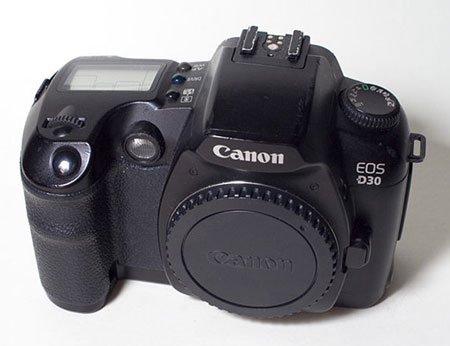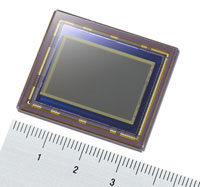The Digital Sensor: A Guide to Understanding Digital Cameras
by Wesley Fink on April 21, 2008 1:00 AM EST- Posted in
- Digital Camera
CCD and CMOS
At the dawn of the digital SLR era, almost every sensor was a CCD (Charge Coupled Device). CCDs were relatively easy to make, but they were and remain basically a single function sensor. CCD sensors create very high image quality and low noise, but they require support circuitry for almost every function provided by the CCD. The CMOS (Complementary Metal Oxide Semiconductor) sensor was always a possible alternative in sensor design, but manufacturing CMOS sensors was very difficult with the technology available at that time. CMOS sensors are inherently lower image quality and higher noise than CCD, which led some experts to predict that a production CMOS sensor for DSLR imaging would never be made.
There are many reasons manufacturers would have preferred the alternative of the CMOS sensor. While difficult to manufacture they are much cheaper to make in volume than CCD sensors. Power consumption for CMOS is inherently lower than the CCD sensor. In addition, the CMOS sensor lends itself to integrating other electronics, such as the analog to digital conversion and noise reduction electronics into the sensor itself - something not really possible with the CCD design.

Those who did not think a commercial CMOS sensor was possible were silenced with the introduction of the $3000 Canon D30 in the fall of 2000. Canon has championed the CMOS sensor, almost exclusively, since that time. However, in the past year other sensor manufacturers have been able to produce their own CMOS sensors. As a result, almost every new sensor introduction in recent months has been CMOS.

In fact, Sony was the first to market with a 12MP+ APS C size CMOS sensor, used in the Nikon D300 and Sony A700. This was followed in about 6 months by the introduction of the Samsung 14.6MP APS-C CMOS sensor in the Pentax K20D. It appears other sensor makers who previously trailed Canon in CMOS development are now the ones pushing the envelope in CMOS sensor development. Sony has also announced a 24.81 effective megapixel CMOS sensor that will be used in a full-frame Sony later this year that will likely be called the A900. The Sony and Samsung thrust into CMOS sensors makes more sense when you realize that Sony and Samsung jointly own several recent patents in CMOS technology. Panasonic is also producing CMOS sensors as seen in their LiveMOS sensors used in the Olympus E-3 and E-501/410/420.

LEFT: Conventional Image CMOS Image Sensor Circuit Structure
RIGHT: Column-Parallel A/D Converter CMOS Image Sensor Circuit Structure
Sony has also taken advantage of another CMOS capability by combining analog to digital conversion and image noise reduction on the CMOS sensor itself in the 12.2MP A700. Some photo review sites had apoplectic fits when they realized Sony was doing noise reduction on the A700 chip, but this is an inevitable development. This move to larger integration of electronics into the CMOS sensor module is just starting, and it could eventually lead to a much larger scale integration of digital image processing functions into the sensor chip - or even a camera on a chip.










72 Comments
View All Comments
andrewln - Monday, April 21, 2008 - link
This was followed in about 6 months by the introduction of the Samsung 14.6MP CMOS sensor in the Pentax D20.should be Pentax K20D
Wesley Fink - Monday, April 21, 2008 - link
Typo corrected. Unfortunately spell check can't catch model numbers that are misstated.araczynski - Monday, April 21, 2008 - link
now i know what pc tech illiterate people feel like :)its a good thing i don't care about photography, interesting read none the less.
finbarqs - Monday, April 21, 2008 - link
the thing is, I've read the reviews and saw the comparisons between the 5D and the D200 (I believe that was the last CCD sensor that Nikon used). The 5D has way better per-pixel sharpness than the D200. Perhaps the technology of the CMOS made it so it finally "looks" better than the CCD. Or at least on the Canon side of things. I'm not biased towards any camera. I've own an XTi, 5D, Panasonic DMC-L1, and now a D300. I'm hoping to own the next 5D MKII (or whatever they call it).Even the D2X used a CMOS sensor, and I thought Nikon made the D300 sensor, as well as the D3 sensor (FF). What I also find "funny" is that Sony doesn't have a FF sensor yet, but nikon does, thus leaving me to believe that Nikon came up with their own FF sensor.
melgross - Monday, April 21, 2008 - link
It's Nikon's own design, though I don't remember who makes it.haplo602 - Monday, April 21, 2008 - link
Nice article Wesley, finaly one Anandtech photo related article I enjoyed reading.On note on the growing megapixel count. Sooner more than later, DSLR in APS-C (and later full frame ones) will hit the same technology wall P&S are facing (too small photosite).
This is one factor that makes me a happy film shooter :-) I know that my limit is the scanner up to around 10MP and I have less flexibility in shooting conditions (either 2 bodies or limited by ISO and film type), in every other situation I am equal or better off.
I am waiting for an affordable Nikon full frame body and then I will make my switch to digital (but that is yet years to come).
wally626 - Monday, April 21, 2008 - link
A sensor technology improves APS-C will be able to go to high enough pixel counts and have very good quality. For most consumers some where around 12 MP is enough, if the sensors improve to where this can hit 3200 ISO with low noise 99 percent of the market would be satisfied.The full frame bodies will replace the medium formats of the film world. There have been some really good medium format cameras that take much better images than 35mm but very few are sold. I think the article is correct in saying the full-frame DSLR will be the PRO cameras and priced as such.
melgross - Monday, April 21, 2008 - link
The number ofpixels is directly related to the print size.If you go by the oft quoted 300 dpi on the final print for maximum quality, you will need a sensor with 2400 x 3600 resolution for a full frame 8 x 12 print, or 8.64 MP. For an 8 x 10, it would be 7.2 MP (4/3 sensor).
For a larger 11 x 17, it would be 3300 x 5100, or 16.83 MP, or 13.86 for the 11 x 14 4/3 sensor print.
You can figure the rest of the sizes my multiplying the inch size of the print edges L x W by 300 to come up with a number.
But the truth is that 240 dpi is going to be good enough fot most prints, and youcan do the numbers that way.
When you know the numbers, you can figure out what size sensor you will need for the highest quality work.
But for most people, even 180 dpi will be enough for their prints. Going to that gives more flexibility, as the sensor pixel count is much smaller.
It's better to get a camera with a longer OPTICAL zoom rather than to go for the biggest number of sensor pixels.
haplo602 - Tuesday, April 22, 2008 - link
^ this ^It's all a matter of print size. I am an amateur/hobbyist, and anything past A4 is large for me. I have printed reasonable quality 8x12 prints from a consumer slide film and home film scanner.
I can hang them up on the wall in a nice frame and they will serve their purpose :-)
Idealy I'd need a 12-14MP full frame Nikon with goot ISO/Noise characteristics (f.e. D3) and it will satisfy my needs for years to come.
Heidfirst - Monday, April 21, 2008 - link
especially as I was wondering the other day what smaller process technology would do for digital sensors?Normally of course smaller process means cooler & more importantly smaller>cheaper to make but of course with sensors you are talking a fixed size so not any cheaper.
But would the potential increased precision of circuitry mean any better image quality?
& a little nitpicking:
Sony didn't buy Konica Minolta (which continues in business) but certain assets from the Photo Imaging division of KM. As to what that actually means there is little hard knowledge outside the 2 companies as it seems that KM still retain some IP & indeed a shareholding in some of the production facilities.
Also, current thinking seems to be that the "A900" may not be called that but something else to differentiate it from the APS-C models.